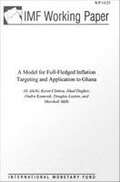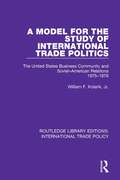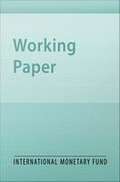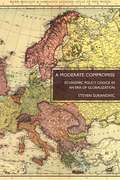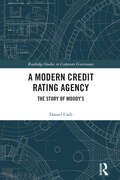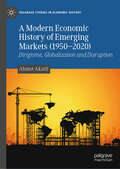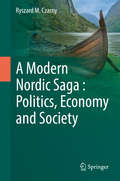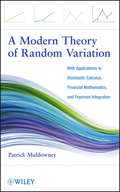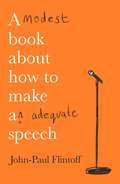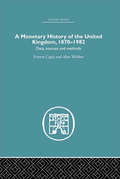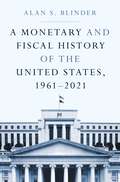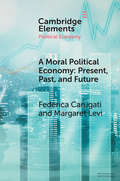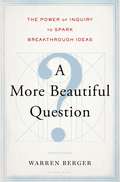- Table View
- List View
A Model for Full-Fledged Inflation Targeting and Application to Ghana
by Ali Alichi Douglas Laxton Jihad Dagher Ondra Kamenik Kevin Clinton Marshall MillsA report from the International Monetary Fund.
A Model for the Study of International Trade Politics: The United States Business Community and Soviet-American Relations 1975-1976 (Routledge Library Editions: International Trade Policy #15)
by William F. Kolarik, Jr.Together with efforts to control the arms race, commercial issues were a central feature of relations between the United States and the Soviet Union in the 1970s. There was a clear recognition that trade and economic issues were of key importance to political relations. This book, first published in 1987, is a comprehensive analysis of the views and perceptions held by Soviet Area Executives of US ‘trade actor’ companies in the critical years 1975-76. It focuses on the key issues of overall US-Soviet relations which formed the environment for commercial relations between the superpowers.
A Model of Multiple Equilibria in Geographic Labor Mobility
by Antonio Spilimbergo Luis UbedaA report from the International Monetary Fund.
A Model of Sovereign Debt in Democracies
by Ali AlichiA report from the International Monetary Fund.
A Moderate Compromise
by Steven SuranovicLooking at all sides of the globalization debate, this book analyzes how international economic policy is made and how it has become so controversial. The author offers a solution to the debate between free trade/unregulated markets and the push for greater government involvement that is consistent with both economic efficiency and social justice
A Modern Approach to Regression with R (Springer Texts in Statistics #Vol. 58)
by Simon SheatherThis book focuses on tools and techniques for building valid regression models using real-world data. A key theme throughout the book is that it only makes sense to base inferences or conclusions on valid models.
A Modern Credit Rating Agency: The Story of Moody’s (Routledge Studies in Corporate Governance)
by Daniel CashThis book aims to present a picture of one of the world’s leading credit rating agencies. Credited as being the first credit rating agency, Moody’s stands as the epitome of the rating sector and all that it effects. However, outside of internal and non-public histories compiled within the rating agency itself, the story of Moody’s has never been told, until now. However, this is not a historical book. Rather, this book paints a picture of Moody’s on a wider canvas that introduces the concept of rating to you, taking into account the origins of the sector, the competitive battles that formed the modern-day oligopoly, and the characters that have each taken their turn on sculpting the industry that, today, is critical to the modern economy. The book is a story of personable people who provided the market with what it needed, but it is more than that. It is a story of conflict, impact, strategy, and most of all the relationship between big business and modern society. Standing as the gatekeeper to the capital markets that form the core of modern society, Moody’s represents the very best of what the marketplace can produce, but also the very worst. This story takes in economic crises in the antebellum US, the Panics of the early 1900s, the Wall Street Crash and the Great Depression and, of course, the Global Financial Crisis. It does this because, at the heart of each one was a member of the rating industry or the reporting industry that preceded it. Associated with almost any financial scandal you may care to remember the credit rating agencies, in their often-uncomfortable role as gatekeepers, have their fingerprints on most financial scandals and calamities. This book tells the story of the industry’s founding member.
A Modern Credit Rating Agency: The Story of Moody’s (Routledge Studies in Corporate Governance)
by Daniel CashThis book aims to present a picture of one of the world’s leading credit rating agencies. Credited as being the first credit rating agency, Moody’s stands as the epitome of the rating sector and all that it effects. However, outside of internal and non-public histories compiled within the rating agency itself, the story of Moody’s has never been told, until now. However, this is not a historical book. Rather, this book paints a picture of Moody’s on a wider canvas that introduces the concept of rating to you, taking into account the origins of the sector, the competitive battles that formed the modern-day oligopoly, and the characters that have each taken their turn on sculpting the industry that, today, is critical to the modern economy.The book is a story of personable people who provided the market with what it needed, but it is more than that. It is a story of conflict, impact, strategy, and most of all the relationship between big business and modern society. Standing as the gatekeeper to the capital markets that form the core of modern society, Moody’s represents the very best of what the marketplace can produce, but also the very worst. This story takes in economic crises in the antebellum US, the Panics of the early 1900s, the Wall Street Crash and the Great Depression and, of course, the Global Financial Crisis. It does this because, at the heart of each one was a member of the rating industry or the reporting industry that preceded it. Associated with almost any financial scandal you may care to remember the credit rating agencies, in their often-uncomfortable role as gatekeepers, have their fingerprints on most financial scandals and calamities. This book tells the story of the industry’s founding member.
A Modern Economic History of Emerging Markets: Dirigisme, Globalization and Disruption (Palgrave Studies in Economic History)
by Ahmet AkarliThis book offers a comprehensive economic history of emerging market economies post-WWII and identifies a complex web of sustainability problems that face the EMEs going forward. It seeks to present a truly global perspective on the development of EMEs and the long-term trends that have brought EMEs to a critical economic juncture. The first section of the book charts how EMEs became tightly integrated into the global economy at rapid pace, analysing economic achievements as well as imbalances and sustainability issues that have been generated over time. It considers how EMEs have withstood episodes of complex structural transitions and financial shocks, and offers comparative perspectives on patterns of dispersion within the EME landscape from the end of WWII to the present. The second part of the book seeks to understand how EMEs might cope with the volatility brought about by a new ‘age of disruption’ defined by major structural challenges to the neo-liberal economic order. It considers which EMEs are best positioned to respond to issues of economic inequality, financial excess, technological disruption and climate change, what a global historical understanding of the EMEs can offer to policymakers, and the impact on the EME investment landscape. This book will be of interest to a broad audience including researchers of economic history and political economy, as well as policymakers, investment professionals, and the general reader interested in global economic development.
A Modern Nordic Saga: Politics, Economy And Society
by Ryszard M. CzarnyThis book focuses on the Nordic countries through a European perspective and wishes to draw attention to their place in the new world order. The volume emphasizes the specificity of their cooperation within the region itself as well as within the European Union, and stresses the importance of the Nordic region as an area of possibilities and tangible chances resulting from the challenges of globalization. The social, cultural, political and economic dimensions of these countries are characterized by cooperation among states, their collaboration with other regional organizations and within international projects, as well as exchange of viewpoints on the specificity of the current Norden issues. The cooperation of the Nordic countries and their inhabitants as well as migrations between the Scandinavian states have been a trademark of the common and shared history of Norden.
A Modern Playbook of Digital Transformation
by Amitabh P. Mishra Ashish RanjanIn order for successful business transformation to occur, there’s an inner transformation that must happen. The innumerable professional forces that tug pell-mell from every imaginable quarter, need to be organized and personal demons exorcized or at least managed. This book takes you through the transformative journey of Dillon, the presumptive head of Digital in one of the world’s largest footwear manufacturers, his private and professional struggle and victory. This modern parable answers the quintessential question: What makes a leader great? Read the step-by-step digital transformation execution plan, complete with tools, artefacts, lessons, pitfalls to avoid and best practices from the industry. If you’ve ever wished for a book that didn’t shy away from delving into the ‘how’ of the execution journey, and while doing so took you on an enjoyable roller coaster ride, look no further. Grab this!
A Modern Theory of Random Variation
by Patrick MuldowneyA ground-breaking and practical treatment of probability and stochastic processes A Modern Theory of Random Variation is a new and radical re-formulation of the mathematical underpinnings of subjects as diverse as investment, communication engineering, and quantum mechanics. Setting aside the classical theory of probability measure spaces, the book utilizes a mathematically rigorous version of the theory of random variation that bases itself exclusively on finitely additive probability distribution functions. In place of twentieth century Lebesgue integration and measure theory, the author uses the simpler concept of Riemann sums, and the non-absolute Riemann-type integration of Henstock. Readers are supplied with an accessible approach to standard elements of probability theory such as the central limmit theorem and Brownian motion as well as remarkable, new results on Feynman diagrams and stochastic integrals. Throughout the book, detailed numerical demonstrations accompany the discussions of abstract mathematical theory, from the simplest elements of the subject to the most complex. In addition, an array of numerical examples and vivid illustrations showcase how the presented methods and applications can be undertaken at various levels of complexity. A Modern Theory of Random Variation is a suitable book for courses on mathematical analysis, probability theory, and mathematical finance at the upper-undergraduate and graduate levels. The book is also an indispensible resource for researchers and practitioners who are seeking new concepts, techniques and methodologies in data analysis, numerical calculation, and financial asset valuation. Patrick Muldowney, PhD, served as lecturer at the Magee Business School of the UNiversity of Ulster for over twenty years. Dr. Muldowney has published extensively in his areas of research, including integration theory, financial mathematics, and random variation.
A Modest Book About How to Make an Adequate Speech
by John-Paul Flintoff<p>"Where I come from, where modesty is a sin, Flintoff 's book would be called 'The Indispensable Guide to Giving an Unforgettable Speech'." Jay Heinrichs, New York Times bestselling author<p> <p>Most of us dread public speaking. But at some point we find ourselves forced to make a speech. And we worry: Will my jokes fall flat? What if I freeze? Is it okay to read notes? What if people walk out?<p> <p>This book won't magically transform you into a fast-talking corporate hotshot. But it will show you how to think about public speaking in a new way, and with a spot of luck, you will achieve adequacy. Or better!<p> <p>Drawing on ancient principles of rhetoric and his own entertaining successes and failures on the speech-giving circuit, John-Paul Flintoff provides simple but effective techniques to help you to speak with confidence to any crowd, whether it's a work presentation or a best friend's wedding.<p> <p>Humble but motivating, this is a guide to finding your voice, even if it's a bit croaky at first, and a reassuring affirmation that we all have something to say.<p>
A Monetary History of Norway, 1816–2016
by Øyvind Eitrheim Jan Tore Klovland Lars Fredrik ØksendalThis book provides a broad overview of monetary developments in Norway over the past 200 years, using a rich variety of graphical illustrations based on a unique data set of historical monetary statistics, which will be documented and made available on the Norges Bank website (in English) at http://www. norges-bank. no/en. Throughout the book, Norway's monetary developments are anchored in a historical context and in the development of monetary thinking. Through their analysis of the historical data, the authors provide new insights and comparisons to other Scandinavian countries, along with an excellent examination of the development and character of the banking and financial system in Norway.
A Monetary History of the United Kingdom: 1870-1982
by Forrest Capie Alan WebberThis book is the culmination of a major research programme on the monetary history of the United Kingdom. This volume contains monetary series ranging from detailed balance sheet material to monetary aggregates such as M3 and are in monthly, quarterly and annual form. The data are drawn mostly from primary sources in the early part of the period and from more accessible published sources for more recent years. Critiques of existing series are given and assessments of the value of different sources are provided. The user should be able to build his/her own series from the basic constituents given here. This sources and assessment of data should be an essential reference to economic historians and applied economists with an interest and use to the students of money and banking and to monetary economists of other countries. This classic book was first published in 1985.
A Monetary History of the United States, 1867-1960 (National Bureau of Economic Research Publications #14)
by Milton Friedman Anna Jacobson SchwartzWriting in the June 1965 issue of theEconomic Journal, Harry G. Johnson begins with a sentence seemingly calibrated to the scale of the book he set himself to review: "The long-awaited monetary history of the United States by Friedman and Schwartz is in every sense of the term a monumental scholarly achievement--monumental in its sheer bulk, monumental in the definitiveness of its treatment of innumerable issues, large and small . . . monumental, above all, in the theoretical and statistical effort and ingenuity that have been brought to bear on the solution of complex and subtle economic issues." Friedman and Schwartz marshaled massive historical data and sharp analytics to support the claim that monetary policy--steady control of the money supply--matters profoundly in the management of the nation's economy, especially in navigating serious economic fluctuations. In their influential chapter 7, The Great Contraction--which Princeton published in 1965 as a separate paperback--they address the central economic event of the century, the Depression. According to Hugh Rockoff, writing in January 1965: "If Great Depressions could be prevented through timely actions by the monetary authority (or by a monetary rule), as Friedman and Schwartz had contended, then the case for market economies was measurably stronger." Milton Friedman won the Nobel Prize in Economics in 1976 for work related to A Monetary History as well as to his other Princeton University Press book, A Theory of the Consumption Function (1957).
A Monetary Policy Model Without Money for India
by Michael Debabrata Patra Muneesh KapurA report from the International Monetary Fund.
A Monetary Theory of Employment
by Warren J. Samuels Lily Xiao Lee Gardiner C. MeansPresents the author's alternative monetary theory and macroeconomics to both the quality theory and Keynes's work. This text reveals Means's view of the economic processes in the real world, and the state of monetary and macroeconomics theory in the mid-1940s.
A Monetary and Fiscal History of Latin America, 1960–2017
by Timothy J. Kehoe Juan Pablo NicoliniA major, new, and comprehensive look at six decades of macroeconomic policies across the region What went wrong with the economic development of Latin America over the past half-century? Along with periods of poor economic performance, the region&’s countries have been plagued by a wide variety of economic crises. This major new work brings together dozens of leading economists to explore the economic performance of the ten largest countries in South America and of Mexico. Together they advance the fundamental hypothesis that, despite different manifestations, these crises all have been the result of poorly designed or poorly implemented fiscal and monetary policies. Each country is treated in its own section of the book, with a lead chapter presenting a comprehensive database of the country&’s fiscal, monetary, and economic data from 1960 to 2017. The chapters are drawn from one-day academic conferences—hosted in all but one case, in the focus country—with participants including noted economists and former leading policy makers. Cowritten with Nobel Prize winner Thomas J. Sargent, the editors&’ introduction provides a conceptual framework for analyzing fiscal and monetary policy in countries around the world, particularly those less developed. A final chapter draws conclusions and suggests directions for further research.A vital resource for advanced undergraduate and graduate students of economics and for economic researchers and policy makers, A Monetary and Fiscal History of Latin America, 1960–2017 goes further than any book in stressing both the singularities and the similarities of the economic histories of Latin America&’s largest countries.Contributors: Mark Aguiar, Princeton U; Fernando Alvarez, U of Chicago; Manuel Amador, U of Minnesota; Joao Ayres, Inter-American Development Bank; Saki Bigio, UCLA; Luigi Bocola, Stanford U; Francisco J. Buera, Washington U, St. Louis; Guillermo Calvo, Columbia U; Rodrigo Caputo, U of Santiago; Roberto Chang, Rutgers U; Carlos Javier Charotti, Central Bank of Paraguay; Simón Cueva, TNK Economics; Julián P. Díaz, Loyola U Chicago; Sebastian Edwards, UCLA; Carlos Esquivel, Rutgers U; Eduardo Fernández Arias, Peking U; Carlos Fernández Valdovinos (former Central Bank of Paraguay); Arturo José Galindo, Banco de la República, Colombia; Márcio Garcia, PUC-Rio; Felipe González Soley, U of Southampton; Diogo Guillen, PUC-Rio; Lars Peter Hansen, U of Chicago; Patrick Kehoe, Stanford U; Carlos Gustavo Machicado Salas, Bolivian Catholic U; Joaquín Marandino, U Torcuato Di Tella; Alberto Martin, U Pompeu Fabra; Cesar Martinelli, George Mason U; Felipe Meza, Instituto Tecnológico Autónomo de México; Pablo Andrés Neumeyer, U Torcuato Di Tella; Gabriel Oddone, U de la República; Daniel Osorio, Banco de la República; José Peres Cajías, U of Barcelona; David Perez-Reyna, U de los Andes; Fabrizio Perri, Minneapolis Fed; Andrew Powell, Inter-American Development Bank; Diego Restuccia, U of Toronto; Diego Saravia, U de los Andes; Thomas J. Sargent, New York U; José A. Scheinkman, Columbia U; Teresa Ter-Minassian (formerly IMF); Marco Vega, Pontificia U Católica del Perú; Carlos Végh, Johns Hopkins U; François R. Velde, Chicago Fed; Alejandro Werner, IMF.
A Monetary and Fiscal History of the United States, 1961–2021
by Alan S. BlinderFrom the New York Times bestselling author, the fascinating story of U.S. economic policy from Kennedy to Biden—filled with lessons for todayIn this book, Alan Blinder, one of the world’s most influential economists and one of the field’s best writers, draws on his deep firsthand experience to provide an authoritative account of sixty years of monetary and fiscal policy in the United States. Spanning twelve presidents, from John F. Kennedy to Joe Biden, and eight Federal Reserve chairs, from William McChesney Martin to Jerome Powell, this is an insider’s story of macroeconomic policy that hasn’t been told before—one that is a pleasure to read, and as interesting as it is important.Focusing on the most significant developments and long-term changes, Blinder traces the highs and lows of monetary and fiscal policy, which have by turns cooperated and clashed through many recessions and several long booms over the past six decades. From the fiscal policy of Kennedy’s New Frontier to Biden’s responses to the pandemic, the book takes readers through the stagflation of the 1970s, the conquest of inflation under Jimmy Carter and Paul Volcker, the rise of Reaganomics, and the bubbles of the 2000s before bringing the story up through recent events—including the financial crisis, the Great Recession, and monetary policy during COVID-19.A lively and concise narrative that is sure to become a classic, A Monetary and Fiscal History of the United States, 1961–2021 is filled with vital lessons for anyone who wants to better understand where the economy has been—and where it might be headed.
A Month at the Brickyard: The Incredible Indy 500
by Sonny KleinfieldAn all-access pass to Pit Row and beyond at the world&’s most famous auto race, the Indianapolis 500The Indianapolis 500 auto race is the most prestigious event in all of motor sports. Race cars roar two hundred times around the track at dizzying speeds of more than two hundred miles per hour in front of a massive crowd—and millions more watching on television. Every spring, drivers, teams, sponsors, and pit crews all come together to make auto-racing history. Since the inaugural race in 1911, the Indy 500 has become one of the most popular sporting events in the world.Award-winning reporter Sonny Kleinfield takes readers inside the world of high-risk, high-speed open-wheel racing. A Month at the Brickyard follows the day-to-day race prep of Indy up-and-comer Johnny Parsons and team, showing the endless fine-tuning and customization up to the big day, as well as capturing the personalities and stories that surround the speedway. With Kleinfield at the wheel, there is much more to racing than just the roar of the engines.
A Moral Political Economy: Present, Past, and Future (Elements in Political Economy)
by Margaret Levi Federica CarugatiEconomies - and the government institutions that support them - reflect a moral and political choice, a choice we can make and remake. Since the dawn of industrialization and democratization in the late eighteenth century, there has been a succession of political economic frameworks, reflecting changes in technology, knowledge, trade, global connections, political power, and the expansion of citizenship. The challenges of today reveal the need for a new moral political economy that recognizes the politics in political economy. It also requires the redesign of our social, economic, and governing institutions based on assumptions about humans as social beings rather than narrow self-serving individualists. This Element makes some progress toward building a new moral political economy by offering both a theory of change and some principles for institutional (re)design.
A More Beautiful Life: A Simple Five-Step Approach to Living Balanced Goals with HEART
by Whitney EnglishA More Beautiful Life walks readers through setting HEART Goals, a proven framework that starts with helping you better understand yourself not by tracking and measuring everything to death but by meeting you right where you are. Traditional goal setting sets us up for failure. Starting from a place of desired outcomes, we attempt to answer the question, &“Where do I want to end up in life?&” Then we attempt to follow a plan that tells us to run in this direction and track our progress with journals, spreadsheets, and complicated tools. Often the plan is too long, too hard, and too elaborate. It&’s not flexible, fluid, or dynamic–in other words, nothing like real life. We focus too much on outcomes, letting the end justify the means, and often forget who we are in the process, missing the point of goal setting altogether. We need a system that allows us to embrace who we are and let that understanding guide us toward a better life. In A More Beautiful Life, Whitney English shares HEART Goals–a system that starts with what matters most to you, never forcing you to adopt arbitrary goals and rules. The process matters, not just the outcomes. This system frees you from comparison and allows you to be authentically yourself. It helps you gain confidence as you make the progress that comes from having done your best instead of the depressing discouragement that comes from comparing yourself to the performances of others. You won&’t have to become someone else to get what you want. H – Help YourselfE – Empower YourselfA – All Your PeopleR – Resources and ResponsibilitiesT – TradeThis is an integrative approach to help you create a more meaningful life that is all yours. You won&’t feel imbalanced or off-center as you pursue one area of success, fearing it will cost you somewhere else. Without any striving, your goals will be aligned with where you want to go in life. You won&’t need to completely change who you are to follow the system. No more deadlines. No more tracking. No more nonsense.
A More Beautiful Question: The Power of Inquiry to Spark Break Through Ideas
by Warren BergerTo get the best answer-in business, in life-you have to ask the best possible question. Innovation expert Warren Berger shows that ability is both an art and a science. <p><p> It may be the most underappreciated tool at our disposal, one we learn to use well in infancy-and then abandon as we grow older. Critical to learning, innovation, success, even to happiness-yet often discouraged in our schools and workplaces-it can unlock new business opportunities and reinvent industries, spark creative insights at many levels, and provide a transformative new outlook on life. It is the ability to question-and to do so deeply, imaginatively, and “beautifully.” <p> In this fascinating exploration of the surprising power of questioning, innovation expert Warren Berger reveals that powerhouse businesses like Google, Nike, and Netflix, as well as hot Silicon Valley startups like Pandora and Airbnb, are fueled by the ability to ask fundamental, game-changing questions. But Berger also shares human stories of people using questioning to solve everyday problems-from “How can I adapt my career in a time of constant change?” to “How can I step back from the daily rush and figure out what really makes me happy?” <p> By showing how to approach questioning with an open, curious mind and a willingness to work through a series of “Why,” “What if,” and “How” queries, Berger offers an inspiring framework of how we can all arrive at better solutions, fresh possibilities, and greater success in business and life.
A Most Valuable Medium: The Remediation of Oral Performance on Early Commercial Recordings
by Richard BaumanBetween 1895 and 1920, the United States saw a sharp increase in commercial sound recording, the first mass medium of home entertainment. As companies sought to discover what kinds of records would appeal to consumers, they turned to performance forms already familiar to contemporary audiences—sales pitches, oratory, sermons, and stories. In A Most Valuable Medium, Richard Bauman explores the practical problems that producers and performers confronted when adapting familiar oral genres to this innovative medium of sound recording. He also examines how audiences responded to these modified and commoditized presentations. Featuring audio examples throughout and offering a novel look at the early history of sound recording, A Most Valuable Medium reveals how this new technology effected monumental change in the ways we receive information.
